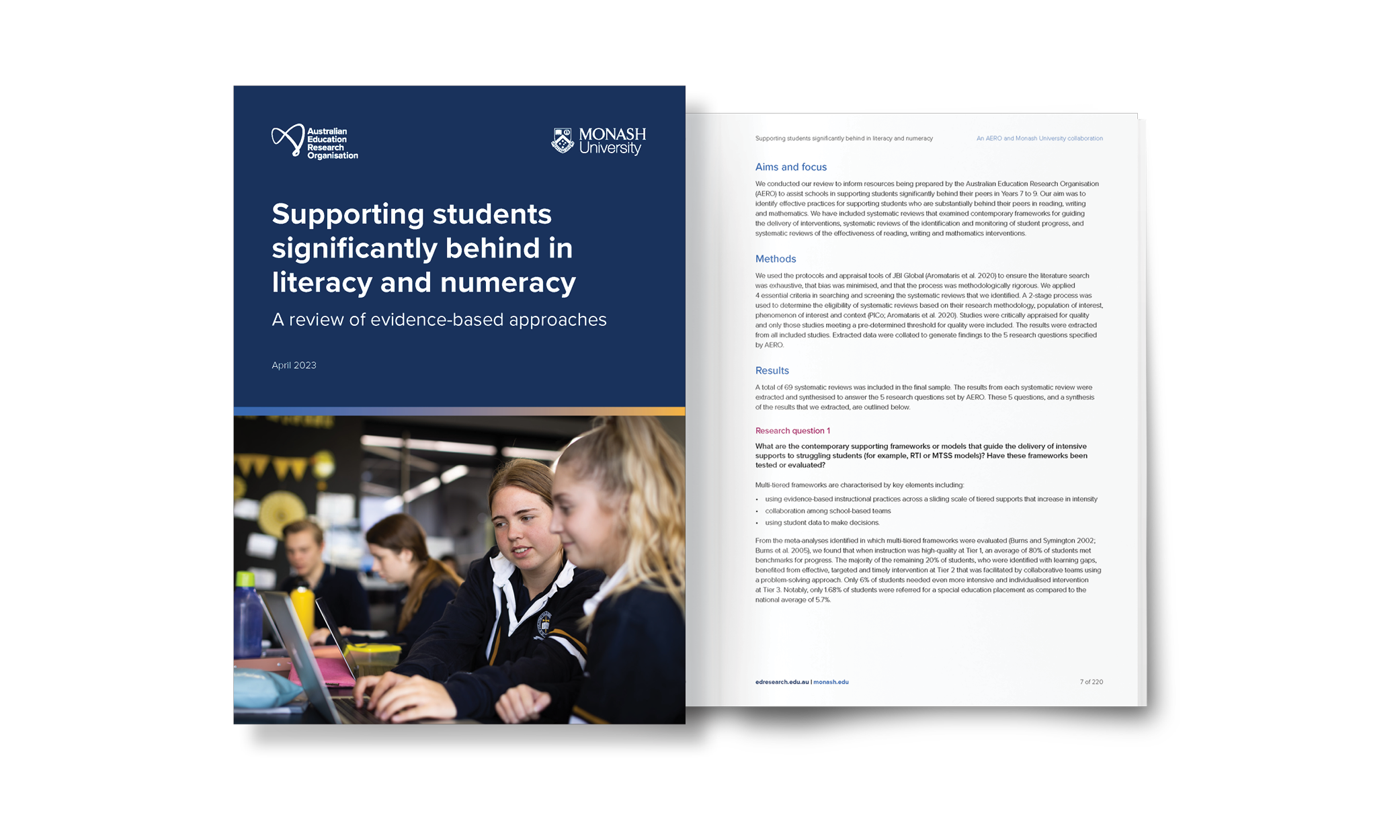In Australia, a substantial proportion of students start secondary school with literacy and numeracy skills that are 3 or more years below those of their peers (ACARA, 2021). Evidence suggests that low literacy and numeracy skills hinder students’ access to the curriculum (Shinn et al., 2016) and can result in poor progress or educational failure. These students are also more likely to face poor outcomes post-school, such as in their health and employment (Australian Institute of Health and Welfare, 2020).

Background
A large body of research has been conducted on literacy and numeracy instruction and interventions for primary school-aged students, as fundamental skills in these domains are generally taught as part of the primary school curriculum. However, less is known about the applicability or effectiveness of interventions for older students who have not mastered these foundational literacy or numeracy skills. Questions also remain about the feasibility of implementing literacy and numeracy interventions within secondary schools, where teachers are typically less familiar with teaching these basic skills and where scheduling constraints exist. In this report, we present the findings of an umbrella review to address these gaps in knowledge.
Literacy and numeracy
For the purposes of our review, we divided literacy into the domains of reading and writing, and we examined the research for interventions that targeted the components of each. For reading, the components included phonemic awareness, decoding, fluency, vocabulary and comprehension. For writing, transcription (handwriting, typing, spelling), text generation (phrases, sentences and compositions) and executive functions (planning, drafting and revising) were included.
Mathematics is defined within the Australian Curriculum as the study of number and algebra, measurement and geometry, and statistics and probability, while numeracy is the application of these skills to other learning areas and to meeting societal demands. We examined interventions for older students related to the acquisition of basic skills across these strands of the mathematics curriculum.
Service delivery frameworks
We examined multi-tiered frameworks such as response to intervention (RTI) and multi-tiered system of supports (MTSS) that have replaced traditional service delivery models internationally, such as in the United States, where multi-tiered frameworks were developed. Traditionally, in Australia and many other countries, support services for underachieving students have been resourced and delivered through a categorical framework that funds and organises services based on students’ identification as belonging to priority equity cohorts, such as Aboriginal and Torres Strait Islander students, students with disability, students from low-socioeconomic backgrounds, students living in regional or remote areas, and students who speak English as an additional language or dialect. This approach, while well-intended, is known to create equity gaps, as some underachieving students are ineligible for support, while others can experience significant delays before services can be provided. In the US, to address these issues with the categorical approach, research was conducted to consider how multi-tiered frameworks, such as those used in public health, could be recast into education to address the inequities and delays of categorical approaches in education. To undertake our review of contemporary approaches most appropriate for organising and delivering supports to underachieving students, we examined these multi-tiered frameworks to identify the implications for Australia.
Aims and focus
We conducted our review to inform resources being prepared by the Australian Education Research Organisation (AERO) to assist schools in supporting students significantly behind their peers in Years 7 to 9. Our aim was to identify effective practices for supporting students who are substantially behind their peers in reading, writing and mathematics. We have included systematic reviews that examined contemporary frameworks for guiding the delivery of interventions, systematic reviews of the identification and monitoring of student progress, and systematic reviews of the effectiveness of reading, writing and mathematics interventions.
Methods
We used the protocols and appraisal tools of JBI Global (Aromataris et al., 2020) to ensure the literature search was exhaustive, that bias was minimised, and that the process was methodologically rigorous. We applied 4 essential criteria in searching and screening the systematic reviews that we identified. A 2-stage process was used to determine the eligibility of systematic reviews based on their research methodology, population of interest, phenomenon of interest and context (PICo; Aromataris et al., 2020). Studies were critically appraised for quality and only those studies meeting a pre-determined threshold for quality were included. The results were extracted from all included studies. Extracted data were collated to generate findings to the 5 research questions specified by AERO.
Conclusion
Despite the gaps identified in the research base, and the dated systematic reviews in some areas, there is sound evidence to support the introduction of MTSS in Australian school systems. The evidence suggests that with consistent use of effective instruction at Tier 1, a team-based problem-solving approach to selecting evidence-based interventions and implementing these with fidelity at Tier 2, 95% of students could meet academic benchmarks. As it was found in the US, this would reserve intensive Tier 3 support only for a small proportion of students in need and reduce the number of special education placements.
Keywords: high school, student support, student progress